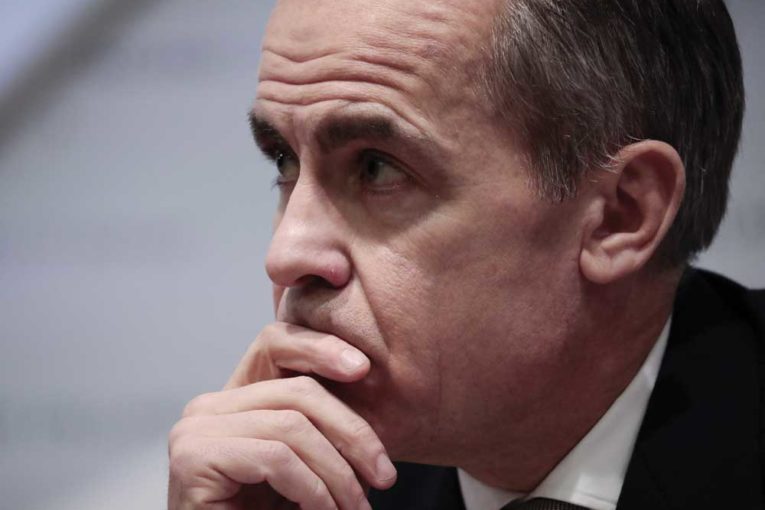
CALGARY — The Canadian oilpatch is concerned that a push led by former Bank of Canada governor Mark Carney to demand further climate disclosures and climate risk assessments from global banks could increase scrutiny of investments in the Canadian oilsands and nascent liquefied natural gas sector.
Carney is set to leave his current job as Bank of England governor later this month to join the United Nations as a special envoy on climate change and finance, where he will be tasked with pushing financial institutions and banks for better disclosure on their investments in fossil fuels.
In an interview with the BBC this week, Carney described how “up to half of developed oil reserves” would likely be stranded in order to limit the effects of climate change. He said that banks and investors need better disclosure and stricter limits on oil, gas and coal investments in order to avoid significant global warming.
“We want action on financing,” Carney said of the goals in his new role with the UN leading up to November’s COP 26 climate conference in Glasgow.
Michael Tims, vice-chairman of Calgary-based Matco Investments, says he’s concerned longer-cycle investments in the oilsands or in LNG projects could be under pressure from Carney’s policies.
“Mark Carney is a thoughtful person so I want to listen closely to what he has to say,” Tims said in an interview.
The shorter-cycle investments in shale oil and gas plays, for example, which pay back their investments in under five years, could escape the kind of investor scrutiny that Carney is advocating, while longer-cycle investments such as in the oilsands, in pipeline projects and LNG export facilities could be affected.
“The harder part is to try to rationally assess what the implications are to value for longer-horizon projects,” Tim said.
Tims noted that investors are demanding more and more disclosure from energy companies on environmental performance. But as more data is being collected and disclosed, financial institutions are struggling to properly evaluate the differences between different types of reserves, different types of assets and climate risks across the sector.
Canadian oil reserves are estimated to be the third largest in the world, after Venezuela and Saudi Arabia. The Canadian oil and gas industry has long been at the centre of the debate about financial institutions and climate change thanks in part to major European banks such as HSBC Plc and BNP Paribas announcing they would not invest in new projects in the oilsands. Large pension funds in Europe and North America have also signalled plans to divest their holdings in heavy oil companies — moves which have hurt the Calgary oilpatch.
Investment in the oilsands has declined from a peak of $33.9 billion in 2014 to an estimated $12 billion last year, according to data from the Canadian Association of Petroleum Producers.
Despite the feeling that the Canadian industry is being unfairly targeted, oil companies and investment managers in Calgary say they’re willing to provide and analyze more data and information on environmental and social performance in the energy sector.
In recent years, multiple investment banks, credit ratings agencies and think tanks — including Moody’s Investors Services and large Canadian banks — have published frameworks for assessing environmental performance and carbon risk across companies and across industries.
Cenovus Energy Inc. spokesperson Sonja Franklin said the oilsands company considers frameworks developed by the Sustainability Accounting Standards Board and the Task Force on Climate Related Disclosures (TCFD) among the “leaders in this space.”
“Through our robust ESG disclosure and reporting practices, which include third-party assurance, we are transparent with shareholders and other stakeholders about our performance and areas we have identified for improvement,” Franklin said in an email.
Carney has spoken at TCFD conferences — which could be a welcome sign for oil and gas producers that favour the organization’s framework for environmental disclosures.
Companies have been trying to figure out what to disclose and how to disclose it. (It’s) still a work in progress.
Allan Fogwill, CEO, Canadian Energy Research Institute
The Canadian oil and gas industry has become more open to requests for data on environmental performance in recent years, said Allan Fogwill, president and CEO of the Canadian Energy Research Institute.
“Companies are trying to figure out what to disclose and how to disclose it,” Fogwill said, adding the development of various disclosure frameworks is “still a work in progress.”
“I don’t think the comparison has been fair at all,” said Tristan Goodman, the president of the Explorers and Producers Association of Canada, which represents small- to mid-size oil and gas producers. He said Canadian oil and gas companies have been scrutinized to a level that their competitors in other countries have not, which is a failing of the approaches by those banks. “I think the banks have done an abysmal job,” he said.
Goodman said that so far global and domestic banks and investment firms have been inconsistent in how they evaluate carbon risks and have unfairly penalized Canadian oil and gas producers compared with their international competitors.
Still, Goodman said Carney’s role in shaping the frameworks for climate disclosure is a welcome sign because the former head of the Bank of Canada is smart enough to understand that a consistent framework is needed globally.
Asked how a bank could evaluate an oil and gas well in Canada versus one in a developing country, Goodman said banks and financial institutions could start by evaluating “simple policies” and environmental regulations between two countries.
“Climate change is not a domestic problem, it’s a global problem,” he said.
• Email:
You can read more of the news on source
